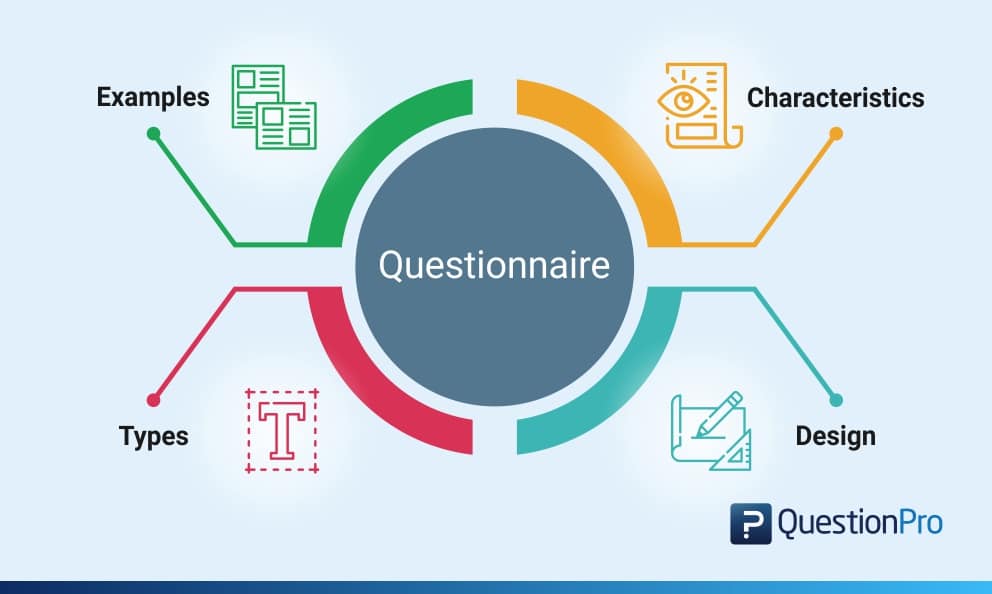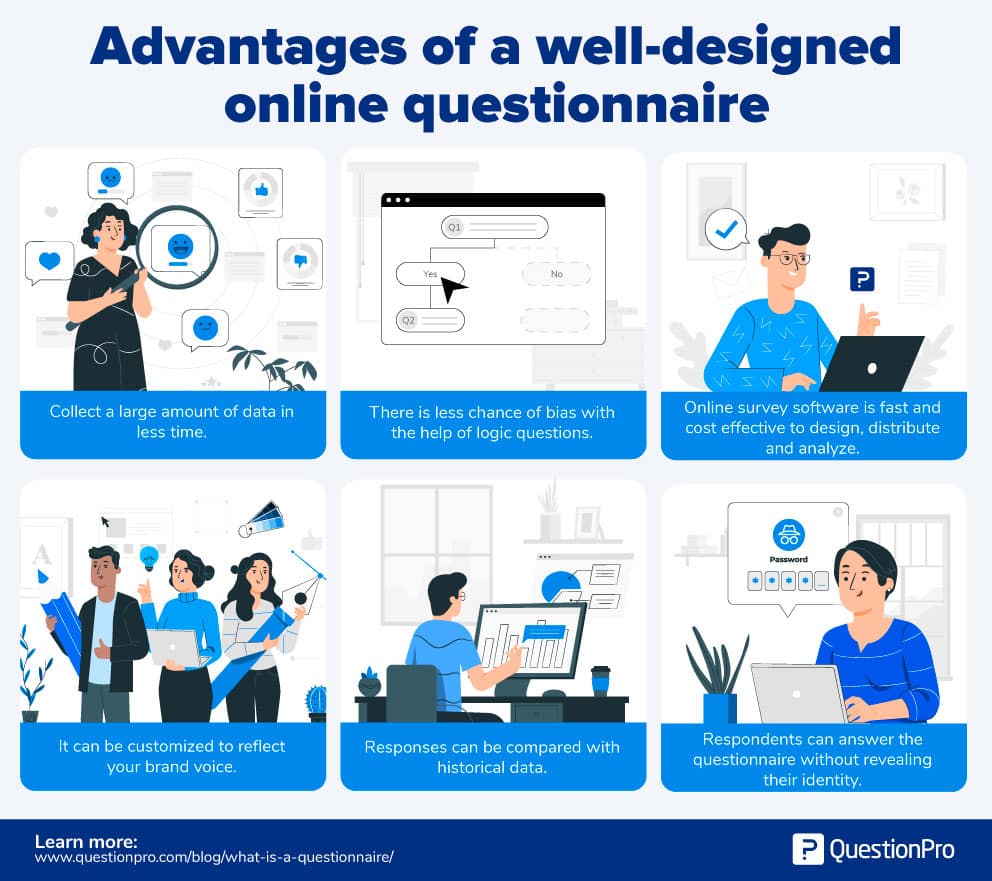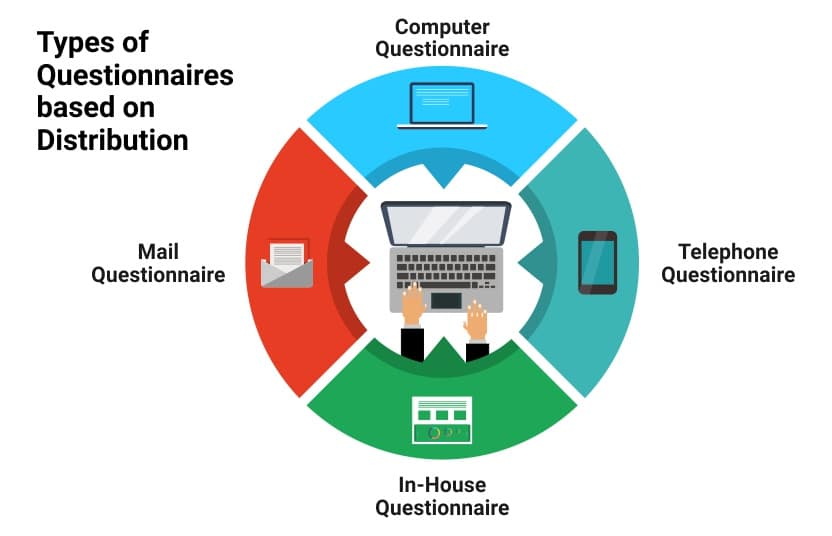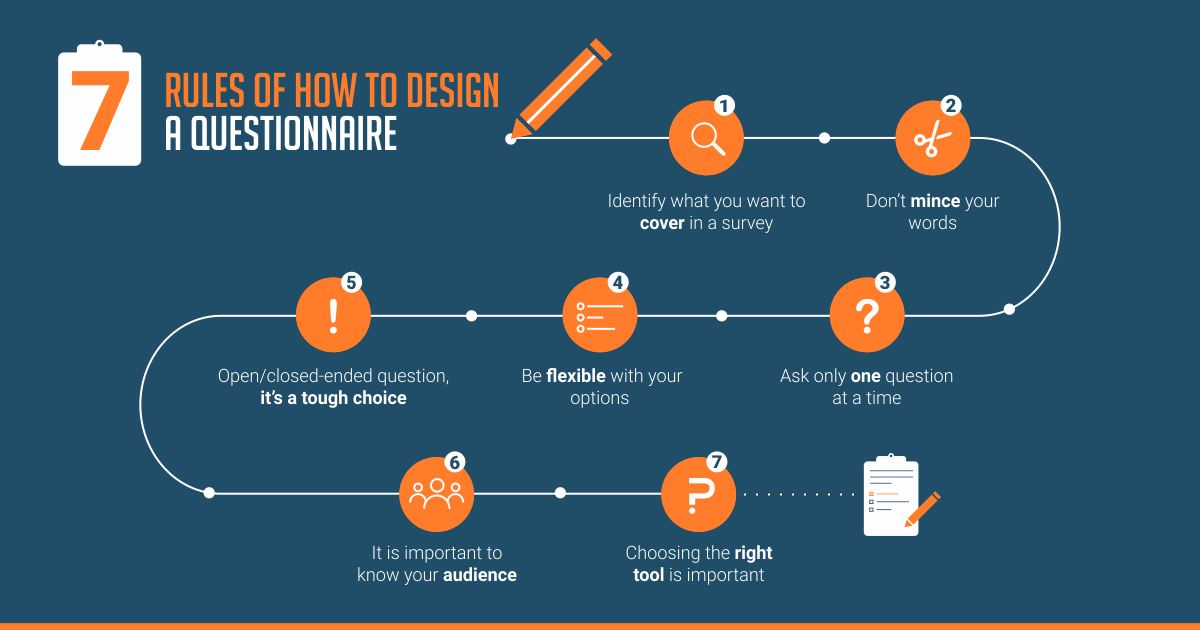Questionnaire: The ultimate guide, advantages & examples

A questionnaire is a research instrument that consists of a set of questions or other types of prompts that aims to collect information from a respondent. A research questionnaire is typically a mix of close-ended questions and open-ended questions .
Open-ended, long-form questions offer the respondent the ability to elaborate on their thoughts. Research questionnaires were developed in 1838 by the Statistical Society of London.
The data collected from a data collection questionnaire can be both qualitative as well as quantitative in nature. A questionnaire may or may not be delivered in the form of a survey , but a survey always consists of a questionnaire.
Advantages of a good questionnaire design
- With a survey questionnaire, you can gather a lot of data in less time.
- There is less chance of any bias(like selection bias) creeping if you have a standard set of questions to be used for your target audience. You can apply logic to questions based on the respondents’ answers, but the questionnaire will remain standard for a group of respondents that fall in the same segment.
- Surveying online survey software is quick and cost-effective. It offers you a rich set of features to design, distribute, and analyze the response data.
- It can be customized to reflect your brand voice. Thus, it can be used to reinforce your brand image.
- The responses can be compared with the historical data and understand the shift in respondents’ choices and experiences.
- Respondents can answer the questionnaire without revealing their identity. Also, many survey software complies with significant data security and privacy regulations.

Characteristics of a good questionnaire
Your survey design depends on the type of information you need to collect from respondents. Qualitative questionnaires are used when there is a need to collect exploratory information to help prove or disprove a hypothesis. Quantitative questionnaires are used to validate or test a previously generated hypothesis. However, most questionnaires follow some essential characteristics:
- Uniformity: Questionnaires are very useful to collect demographic information, personal opinions, facts, or attitudes from respondents. One of the most significant attributes of a research form is uniform design and standardization. Every respondent sees the same questions. This helps in data collection and statistical analysis of this data. For example, the retail store evaluation questionnaire template contains questions for evaluating retail store experiences. Questions relate to purchase value, range of options for product selections, and quality of merchandise. These questions are uniform for all customers.
- Exploratory: It should be exploratory to collect qualitative data. There is no restriction on questions that can be in your questionnaire. For example, you use a data collection questionnaire and send it to the female of the household to understand her spending and saving habits relative to the household income. Open-ended questions give you more insight and allow the respondents to explain their practices. A very structured question list could limit the data collection.
- Question Sequence: It typically follows a structured flow of questions to increase the number of responses. This sequence of questions is screening questions, warm-up questions, transition questions, skip questions, challenging questions, and classification questions. For example, our motivation and buying experience questionnaire template covers initial demographic questions and then asks for time spent in sections of the store and the rationale behind purchases.
Types & Definitions
As we explored before, questionnaires can be either structured or free-flowing. Let’s take a closer look at what that entails for your surveys.
- Structured Questionnaires: Structured questionnaires collect quantitative data. The questionnaire is planned and designed to gather precise information. It also initiates a formal inquiry, supplements data, checks previously accumulated data, and helps validate any prior hypothesis.
- Unstructured Questionnaires: Unstructured questionnaires collect qualitative data. They use a basic structure and some branching questions but nothing that limits the responses of a respondent. The questions are more open-ended to collect specific data from participants.
Types of questions in a questionnaire
You can use multiple question types in a questionnaire. Using various question types can help increase responses to your research questionnaire as they tend to keep participants more engaged. The best customer satisfaction survey templates are the most commonly used for better insights and decision-making.
Some of the widely used types of questions are:
- Open-Ended Questions:Open-ended questions help collect qualitative data in a questionnaire where the respondent can answer in a free form with little to no restrictions.
- Dichotomous Questions: The dichotomous question is generally a “yes/no” close-ended question. This question is usually used in case of the need for necessary validation. It is the most natural form of a questionnaire.
- Multiple-Choice Questions:Multiple-choice questions are a close-ended question type in which a respondent has to select one (single-select multiple-choice question) or many (multi-select multiple choice question) responses from a given list of options. The multiple-choice question consists of an incomplete stem (question), right answer or answers, incorrect answers, close alternatives, and distractors. Of course, not all multiple-choice questions have all of the answer types. For example, you probably won’t have the wrong or right answers if you’re looking for customer opinion.
- Scaling Questions: These questions are based on the principles of the four measurement scales – nominal, ordinal, interval, and ratio. A few of the question types that utilize these scales’ fundamental properties are rank order questions, Likert scale questions, semantic differential scale questions, and Stapel scale questions.
- Pictorial Questions: This question type is easy to use and encourages respondents to answer. It works similarly to a multiple-choice question. Respondents are asked a question, and the answer choices are images. This helps respondents choose an answer quickly without over-thinking their answers, giving you more accurate data.
Types of Questionnaires

Questionnaires can be administered or distributed in the following forms:
- Online Questionnaire: In this type, respondents are sent the questionnaire via email or other online mediums. This method is generally cost-effective and time-efficient. Respondents can also answer at leisure. Without the pressure to respond immediately, responses may be more accurate. The disadvantage, however, is that respondents can easily ignore these questionnaires. Read more about online surveys.
- Telephone Questionnaire: A researcher makes a phone call to a respondent to collect responses directly. Responses are quick once you have a respondent on the phone. However, a lot of times, the respondents hesitate to give out much information over the phone. It is also an expensive way of conducting research. You’re usually not able to collect as many responses as other types of questionnaires, so your sample may not represent the broader population.
- In-House Questionnaire: This type is used by a researcher who visits the respondent’s home or workplace. The advantage of this method is that the respondent is in a comfortable and natural environment, and in-depth data can be collected. The disadvantage, though, is that it is expensive and slow to conduct.
- Mail Questionnaire: These are starting to be obsolete but are still being used in some market research studies. This method involves a researcher sending a physical data collection questionnaire request to a respondent that can be filled in and sent back. The advantage of this method is that respondents can complete this on their own time to answer truthfully and entirely. The disadvantage is that this method is expensive and time-consuming. There is also a high risk of not collecting enough responses to make actionable insights from the data.
How to design a Questionnaire

Questionnaire design is a multistep process that requires attention to detail at every step.
Researchers are always hoping that the responses received for a survey questionnaire yield useable data. If the questionnaire is too complicated, there is a fair chance that the respondent might get confused and will drop out or answer inaccurately.
As a survey creator, you may want to pre-test the survey by administering it to a focus group during development. You can try out a few different questionnaire designs to determine which resonates best with your target audience. Pre-testing is a good practice as the survey creator can comprehend the initial stages if there are any changes required in the survey.
Steps Involved in Questionnaire Design
1. Identify the scope of your research:
Think about what your questionnaire is going to include before you start designing the look of it. The clarity of the topic is of utmost importance as this is the primary step in creating the questionnaire. Once you are clear on the purpose of the questionnaire, you can begin the design process.
2. Keep it simple:
The words or phrases you use while writing the questionnaire must be easy to understand. If the questions are unclear, the respondents may simply choose any answer and skew the data you collect.
3. Ask only one question at a time:
At times, a researcher may be tempted to add two similar questions. This might seem like an excellent way to consolidate answers to related issues, but it can confuse your respondents or lead to inaccurate data. If any of your questions contain the word “and,” take another look. This question likely has two parts, which can affect the quality of your data.
4. Be flexible with your options:
While designing, the survey creator needs to be flexible in terms of “option choice” for the respondents. Sometimes the respondents may not necessarily want to choose from the answer options provided by the survey creator. An “other” option often helps keep respondents engaged in the survey.
5. The open-ended or closed-ended question is a tough choice:
The survey creator might end up in a situation where they need to make distinct choices between open or close-ended questions. The question type should be carefully chosen as it defines the tone and importance of asking the question in the first place.
If the questionnaire requires the respondents to elaborate on their thoughts, an open-ended question is the best choice. If the surveyor wants a specific response, then close-ended questions should be their primary choice. The key to asking closed-ended questions is to generate data that is easy to analyze and spot trends.
6. It is essential to know your audience:
A researcher should know their target audience. For example, if the target audience speaks mostly Spanish, sending the questionnaire in any other language would lower the response rate and accuracy of data. Something that may seem clear to you may be confusing to your respondents. Use simple language and terminology that your respondents will understand, and avoid technical jargon and industry-specific language that might confuse your respondents.
For efficient market research, researchers need a representative sample collected using one of the many sampling techniques, such as a sample questionnaire. It is imperative to plan and define these target respondents based on the demographics required.
7. Choosing the right tool is essential:
QuestionPro is a simple yet advanced survey software platform that the surveyors can use to create a questionnaire or choose from the already existing 300+ questionnaire templates.
Always save personal questions for last. Sensitive questions may cause respondents to drop off before completing. If these questions are at the end, the respondent has had time to become more comfortable with the interview and are more likely to answer personal or demographic questions.
Differences between a Questionnaire and a Survey
| Questionnaire | Survey |
| Meaning | A questionnaire can is a research instrument that consists of a set of questions to collect information from a respondent. | A survey is a research method used for collecting data from a pre-defined group of respondents to gain information and insights on various topics of interest. |
| What is it? | The instrument of data collection | Process of collecting and analyzing that data |
| Characteristic | Subset of survey | Consists of questionnaire and survey design, logic and data collection |
| Time and Cost | Fast and cost-effective | Much slower and expensive |
| Use | Conducted on the target audience | Distributed or conducted on respondents |
| Questions | Close-ended and very rarely open-ended | Close-ended and open-ended |
| Answers | Objective | Subjective or objective |
Questionnaire Examples
The best way to understand how questionnaires work is to see the types of questionnaires available. Some examples of a questionnaire are:
- Customer Satisfaction Questionnaire: This type of research can be used in any situation where there’s an interaction between a customer and an organization. For example, you might send a customer satisfaction survey after someone eats at your restaurant. You can use the study to determine if your staff is offering excellent customer service and a positive overall experience. USE THIS FREE TEMPLATE
- Product Use Satisfaction: You can use this template to better understand your product’s usage trends and similar products. This also allows you to collect customer preferences about the types of products they enjoy or want to see on the market. USE THIS FREE TEMPLATE
- Company Communications Evaluation: Unlike the other examples, a company communications evaluation looks at external and internal communications. It can be used to check if the policies of the organization are being enforced across the board, both with employees and clients. USE THIS FREE TEMPLATE
The above survey questions are typically easy to use, understand, and execute. Additionally, the standardized answers of a survey questionnaire instead of a person-to-person conversation make it easier to compile useable data.
The most significant limitation of a data collection questionnaire is that respondents need to read all of the questions and respond to them. For example, you send an invitation through email asking respondents to complete the questions on social media. If a target respondent doesn’t have the right social media profiles, they can’t answer your questions.





